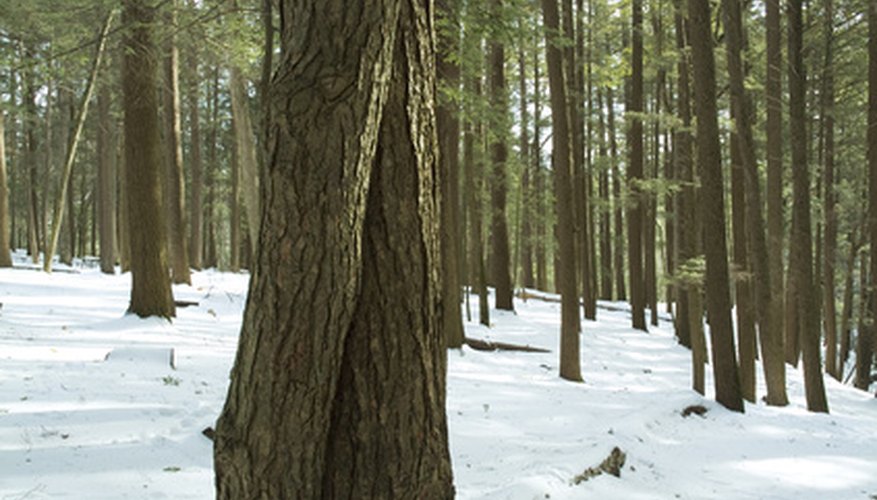The eastern hemlock (Tsuga canadensis) and the western hemlock (Tsuga heterophylla) are conifers native to North America. The eastern hemlock also goes by the names Canada hemlock and hemlock spruce. The western hemlock is also called the west coast hemlock, Pacific hemlock and coast hemlock. Although called hemlocks, neither tree is related to the poison hemlock, a European plant.
Appearance
Both trees have a conical shape, though the tops of western hemlocks droop. Both have small, flat needles that grow in two rows along each branch. The eastern hemlock’s needles reach about 2/3 inches in length, while those of the western hemlock vary from 1/4 to 3/4 inches long. The cones of both trees hang from the ends of the branches. The western hemlock‘s cones, which are about 3/4 to 1 inch long, are slightly larger than those of the eastern hemlock, whose cones are smaller than those of any other species in the genus. Each species has furrowed bark. That of the eastern hemlock is cinnamon coloured, while that of the western hemlock starts out reddish brown but turns dark brown as it ages.
- Both trees have a conical shape, though the tops of western hemlocks droop.
- That of the eastern hemlock is cinnamon coloured, while that of the western hemlock starts out reddish brown but turns dark brown as it ages.
Range
As their names suggest, the two species grow on opposite sides of the continent. The eastern hemlock grows in the Canadian provinces of Nova Scotia, New Brunswick, Quebec and Ontario. It is also found throughout the northeastern United States, as far west as northern Minnesota and as far south as the mountains of Georgia and Alabama. The western hemlock grows in the states of California, Oregon, Washington, Idaho, Montana and Alaska as well as the Canadian provinces of British Columbia and Alberta.
- As their names suggest, the two species grow on opposite sides of the continent.
- The eastern hemlock grows in the Canadian provinces of Nova Scotia, New Brunswick, Quebec and Ontario.
Growing Conditions
Both species do best in cool, moist environments. Although they require plenty of sunlight and acidic soils to achieve maximum growth, they perform well in shade and various kinds of soil. The eastern hemlock will grow at altitudes ranging from sea level to about 5,000 feet. The western hemlock grows at altitudes up to about 6,000 feet.
- Both species do best in cool, moist environments.
- The eastern hemlock will grow at altitudes ranging from sea level to about 5,000 feet.
Growth and Lifespan
The eastern hemlock can grow over 100 feet tall, whereas the western hemlock can exceed 200 feet. However, the eastern hemlock has a longer lifespan--over 900 years. According to the Western North Carolina Nature Center, one specimen is known to have lived 988 years. The western hemlock’s lifespan is about 400 to 500 years.
- The eastern hemlock can grow over 100 feet tall, whereas the western hemlock can exceed 200 feet.
- However, the eastern hemlock has a longer lifespan--over 900 years.
Uses
Rich in tannin, the bark of both species used to be a major source of the substance for the tanning industry. Their wood remains an important source of pulp for making paper. Unlike its eastern cousin, the western hemlock is also an important timber tree. Its easily worked wood is used to make doors, windows, kitchen cabinets, flooring and a variety of other items for housing construction. Because of their resistance to insects and disease, shade tolerance and attractive foliage, both trees are used as ornamentals or to create screens or hedges.
- Rich in tannin, the bark of both species used to be a major source of the substance for the tanning industry.
